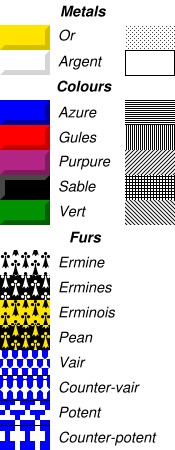Tincture
There are seven principal tinctures used in Blazoning heraldry, consisting of two metals (light tinctures) and five colours (dark tinctures).
Rule of Tincture
The first rule of heraldry is the rule of tincture: metal should not be put on metal, nor colour on colour (Humphrey Llwyd, 1568). This means that or and argent (gold and silver, which are represented by yellow and white) may not be placed on each other, and neither may one of the colours (tinctures that are neither or nor argent) be placed on another colour.
The main duty of a heraldic device is to be easily recognisable. It has been deemed that certain tincture pairs are difficult to distinguish when placed atop or next to each other. Specifically, a dark colour is very difficult to distinguish if it is placed on top of another dark colour, and likewise a light metal is very difficult to distinguish on top of another light metal. When fields or charges are divided into bands of alternating tinctures, the tinctures of the bands alternate between a colour and a metal next to each other.
This rule is so closely followed that arms that violate it are called armes fausses (false arms) or armes à enquérir (arms of enquiry); any violation is presumed to be intentional, to the point that one is supposed to enquire how it came to pass. One of the most famous armes à enquérir (often said to be the only example) was the shield of the Kingdom of Jerusalem, which had gold crosses on silver. This use of metal on metal, that is to say white and gold together, is seen on the Arms of the King of Jerusalem, the flag and Arms of the Vatican, and the Bishop's mitre in the Arms of Andorra. It indicates the exceptional holy and special status of the Coat of Arms. (In the case of Jerusalem, this may also emphasize the Arab techniques gained in the Levant). An example of "colour on colour" is the arms of Albania, with its sable two-headed eagle on a gules field.
Though this is the practical genesis of the rule, the rule is technical and appearance is not used in determining whether arms conform to the rule. Another reason sometimes given to justify this rule is that it was difficult to paint with enamel (colour) over enamel, or with metal over metal.
The rule of tincture does not apply to furs (so furs are sometimes called "amphibious"), nor to charges proper (in natural, what is supposed to be natural, or conventional colouration). (The blazoning of a charge "proper" can be used as a type of loophole when its natural colouration is or approaches another heraldic tincture and, if so blazoned, it would violate the rule of tincture. This has occasionally gone so far as to say, for example, a white horse proper -- a "white horse proper" could be placed on an or field, but "a horse argent" could not, though the two are identical in appearance.) Furs and charges blazoned as proper can be placed on colour, metal, fur, or other charges blazoned as proper.
Simple divisions of the field are considered to be beside each other, not one on top of the other; so the rule of tincture does not apply. In practice, however, fields divided into multiple partitions, such as checky or lozengy, use an alternating pattern of metal and colour for adjacent units.
The rule also does not apply to charges placed upon party-coloured (divided) or patterned fields; a field party or patterned of a colour and metal may have a charge of either colour, metal, or party or patterned, placed on it (and there is a small body of precedent that a field party of two colours or two metals may have a charge or charges of either colour, metal, or party or patterned on it. Likewise, a party-coloured (of colour and metal) charge may be placed on either a colour or metal background. Neither does the rule apply to the tongue, horns, claws, hoofs of beasts (for instance, a lion or on an azure field could be langued [with his tongue] gules) when of a different tincture than the rest of the animal, or other parts of charges that are "attached" to them -- for instance, a ship sable on an or field may have argent sails as the sails are considered to be attached on the ship rather than charged on the field.
Another apparent violation that is not regarded as such is the "very uncommon" practice of a bordure of the same tincture of the field being blazoned as "embordured;" while well-known in former times this is unusual in the extreme today.
The colours bleu celeste and the U.S. Institute of Heraldry-invented buff have sometimes been treated (with respect to the rule of tincture) as if they are metals, though such a treatment is certainly of debatable propriety.
Variations of Colours
There are seven common Tinctures.
Stains
Only three are of more than exceptional use in British heraldry:
- murrey (mulberry-coloured),
- sanguine (blood-red)
- tenné (orange or tan, though in continental heraldry orange is regarded as different.
Rare Tinitures
- Bleu Celeste -Sky Blue (considered improper by many because of it's late invention).
- Brunâtre - Continental colours
- Buff - often employed as a metal, invented by the US institute of heraldry.
- Carnation - he colour of European human skin or pale pink.
- Cendrée - the colour of Iron and Walls, Ash Coloured.
- De piedra - Spanish Heraldry, meaning the colour of stone, or grey.
Furs
- Vair
- Counter-vair
- Vair in pale
- Vair en pointe
- Ermine
- Ermines (counter-ermine)
- Erminois
- Potent
- Kursch
